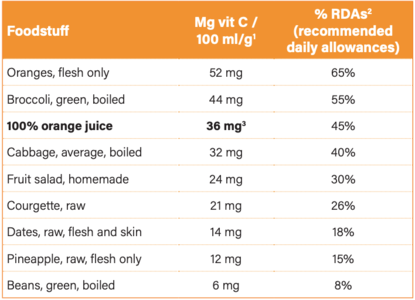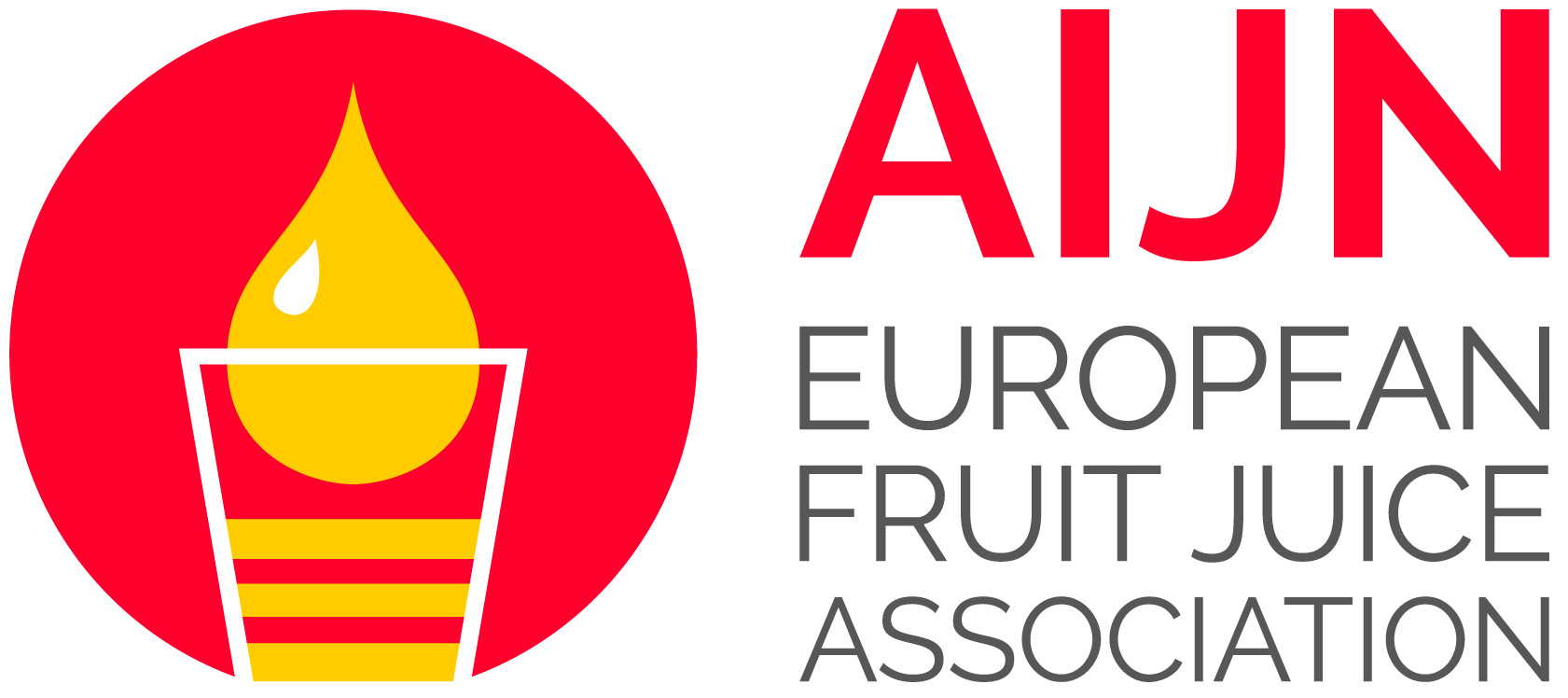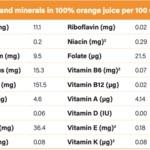Publications
The Micronutrients in Orange Juice
Juice, a catalysing vitamin supplier
One small glass (150 ml) of 100% orange juice contains more than 50% of your daily requirement4 of Vitamin C, and helps ensure that the iron from fruit & vegetables is well-absorbed by our bodies.5

Vitamins and minerals in general: Drinking 100% fruit juice is a convenient and delicious way to top up fruit & vegetable consumption. For children, it is shown to be to be an important source of potassium and has been positively linked to achieving recommended intakes of Vitamin C and folate.5 Fruit and vegetables are among the most important foods to give us enough vitamins and minerals.6
Vitamin C: Vitamin C helps reduce tiredness and fatigue.7 Vitamin C is a natural activator; our body’s absorption of iron from non-meat sources improves when eaten with food or drinks containing Vitamin C.5 On top of this, Vitamin C is essential for structure of bones, cartilage, muscle and blood vessels, and helps to maintain capillaries and gums.8

Potassium: Potassium contributes to normal muscle function and to the maintenance of normal blood pressure.2 The 227 mg of potassium in 1 small glass of 150 ml orange juice contributes 10% of your daily requirement. The European Food Information Council points out that dealing with raised blood pressure is not just about cutting back on certain foods, but is also about eating more of others. It has been estimated that an increase of 2.3–3.1 g of potassium a day could reduce deaths related to raised blood pressure by as much as 25%. This quantity of potassium can be found in a banana, a large glass of orange juice, and single portions of many other fruits and vegetables.9
Folate: Folate is a bit of an unknown benefactor. It contributes to maternal tissue growth during pregnancy and to the normal function of the immune system. Moreover, it helps to reduce tiredness and fatigue.1 Folate is also associated with good mental health, and it seems to be necessary to eat the food instead of taking the tablet. A panel of the European Food Safety Authorities concludes that a ‘cause and eff ect’ relationship has been established between the dietary intake of folate and contribution to normal psychological functions.10
Phytonutrients: The health benefits of phytonutrients, also known as plant compounds, are not yet fully understood and are the subject of much experimental and innovative science. For example, “more than 5000 individual dietary phytochemicals have been identified in fruits, vegetables, whole grains, legumes, and nuts, but a large percentage of them still remain unknown.”11 Research suggests that phytonutrients can work in synergy with common nutrients, such as Vitamin C, to support health. Ongoing research remarks how plant compounds affect conditions with an inflammation component, such as cardiovascular disease, metabolic syndrome, insulin resistance and some types of cancer. Hesperidin, one of many phytonutrients found in orange juice for example, has been suggested in studies to contribute to favourable changes in blood pressure.5
Antioxidants: While oxygen is one of the most essential components of life, it is highly reactive and capable of potentially damaging human cells through the production of “free radicals”. Antioxidants in fruit juice are for example flavonoids. Although juicing oranges dramatically cuts flavonoid levels, the remaining ones were much more bio-accessible than those in orange segments.12 Partly due to their presence, these antioxidants might protect the body’s cells from free radical damage. However, this protective effect is not due to Vitamin C alone, suggesting that other important nutrients are at work in orange juice.13
Bioavailability: refers to the proportion of a nutrient that is absorbed from the diet and used for normal body functions. Micronutrients, i.e. vitamins and minerals, and bioactive phytochemicals (e.g. flavonoids, carotenoids) can vary widely in the extent they are absorbed and utilised. The absorption of straight Vitamin C in most supplements is poor, in comparison to the Vitamin C absorbed from an orange or orange juice. The digestibility of food matrices, especially of plant foods, is also aided by cooking or pureeing. For example, whereas raw fruit and vegetables are sources of dietary fibre, cooking them allows the human body to also extract a much larger amount of the carotenoids contained. Combining fruit juice with other healthy foods also influences the bioavailability; for example, having a glass of orange juice with a bowl of breakfast cereal helps the body use more of the iron in the cereal.14
Definition on 100% FJ + composition of 100 OJ
100% orange juice is made by squeezing or crushing fruit. Nothing else is added. For example, with commercially prepared 100% orange juice (not from concentrate) the oranges are first squeezed then lightly pasteurised before packing. Juice from concentrate has the water extracted after pasteurisation, which is then added back in later (for example, after being shipped from Brazil to Europe). It is prohibited by European law to add sugars to 100% fruit juice15, whether the juice comes from concentrate or not. Composition of 100% orange juice Water (around 90%), natural sugars from fruit, Vitamin C, folate, potassium and other vitamins, minerals and phytonutrients
Nutritional suggestion
To get the most out of your salad at lunch, combine it with a glass of 100% orange juice. You get all the nutrients of orange juice plus increased absorption of the iron in your greens. A tasty way to get nutritionally satisfied!
References
1 UK national database on foodstuff,The McCance and Widdowson’s composition of foods integrated dataset (publication 2015)
2 COUNCIL DIRECTIVE of 24 September 1990 on nutrition labelling for foodstuffs (90/496/EEC) (OJ L 276, 6.10.1990, p. 40)
3 Average of the date of national nutrient databases from UK, Germany, France, The Netherlands, Belgium, Spain, Italy, Portugal, Denmark, Finland, Austria
4 EFSA report of 2003, Opinion of the Scientific Committee on Food on the revision of reference values for nutrition labelling (expressed on 5 March 2003)
5 Morand C, Dubray C, Milenkovic D, Lioger D, Martin JF, Scalbert A, Mazur A. Hesperidin contributes to the vascular protective effects of orange juice: a randomized crossover study in healthy volunteers. Am J Clin Nutr. 2011 Jan;93(1):73-80. doi: 10.3945/ajcn.110.004945
6 http://www.eufic.org/article/en/page/TARCHIVE/expid/10-healthy-eating-tips-kids
7 Commission Regulation (EU) 432/2012 of 16/05/2012
8 http://www.eufic.org/article/en/page/MARCHIVE/expid/miniguide-vitamins/#10
9 http://www.eufic.org/article/en/page/FTARCHIVE/artid/men-diet-health/
10 Panel on Dietetic Products, Nutrition and Allergies ; EFSA Journal: EFSA Journal 2010;8(10):1760 [19 pp.]
11 Lui R. Health-Promoting Components of Fruits and Vegetables in the Diet. Adv. Nutr. 4: 384S–392S. 2013, p 384S
12 Julian K. Aschoff, Sabrina Kaufmann, Onur Kalkan, Sybille Neidhart, Reinhold Carle, Ralf M. Schweiggert. In Vitro Bioaccessibility of Carotenoids, Flavonoids, and Vitamin C from Differently Processed Oranges and Orange Juices [Citrus sinensis(L.) Osbeck]. Journal of Agricultural and Food Chemistry, 2015; 63 (2): 578 DOI:10.1021/jf505297t
13 http://www.eufic.org/page/en/show/latest-science-news/page/LS/fftid/antioxidantjuice-vitaminC/
14 http://www.eufic.org/article/en/artid/Nutrient-bioavailability-food/ 15 Official Journal of the European Union. Directive 2012/12/EU of the European Parliament and of the Council. Available at: http://eur-lex.europa.eu/LexUriServ/LexUriServ. do?uri=OJ:L:2012:115:0001:0011:EN:PDF


